This buttery vegan brioche bread has a fluffy and tender crumb that melts in your mouth. It's made with only 7 simple pantry ingredients and is egg-free and dairy-free!
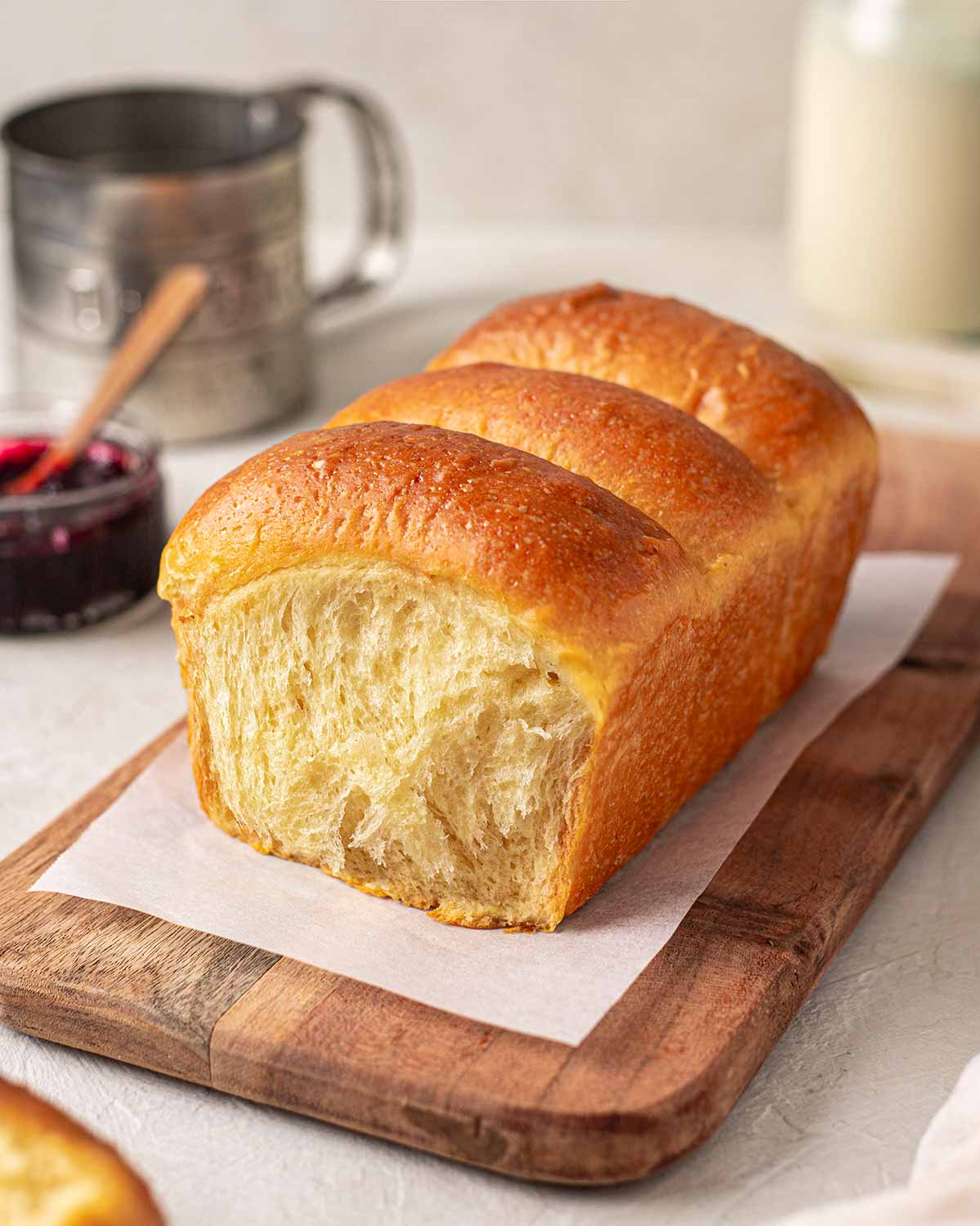
Table of contents
Simple ingredients you'll need
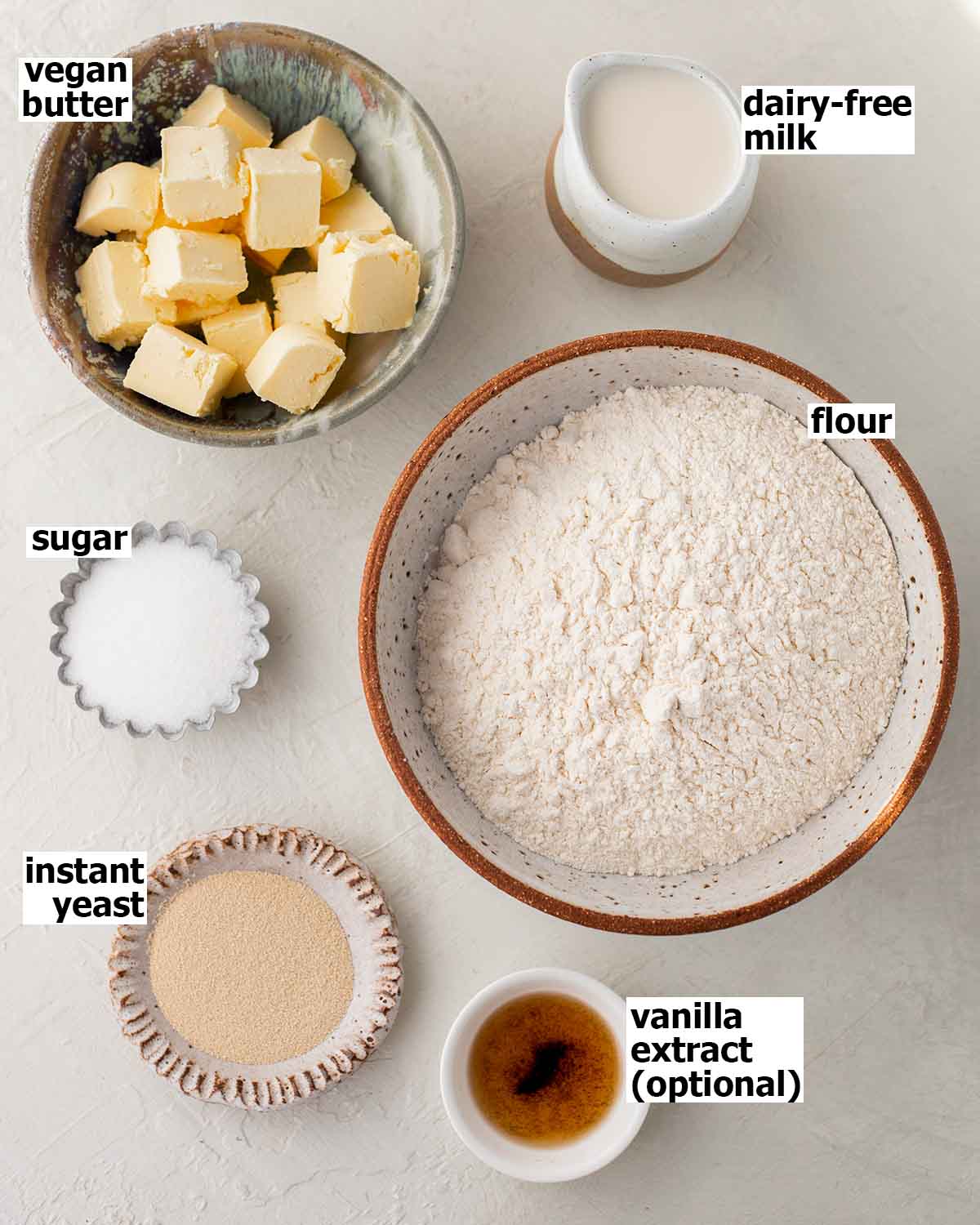
Notes about the ingredients
Bread flour or all-purpose plain flour. All-purpose flour creates a cakier vegan brioche whereas bread flour gives the brioche a slight 'chew'.
Vegan butter creates a rich and tender texture that's typical of traditional brioche and makes it different from sandwich bread.
Dairy-free milk. I prefer soy milk as it's higher protein and creates a richer brioche. However, any dairy-free milk will work.
Instant-dried yeast because it's easier and quicker to use than any other yeast. Or you can use dry or fresh yeast, as long as you proof it first.
Traditionally, French brioche bread is enriched with eggs or egg yolks. However, by increasing the amount of fat through butter and rising power through yeast, we can create an eggless and dairy-free brioche that is soft, fluffy and tender.
The full list of ingredient quantities and instructions are in the gray recipe card at the bottom of this post.
Two different kneading methods
You can knead the dough by hand or in a stand mixer. However, there are two different methods for kneading the dough.
- Easy method where you knead all the ingredients at the same time. This takes 5-10 minutes and makes a soft and buttery brioche. If you're kneading by hand, this is the best method for you (left picture).
- Traditional advanced method where you add the butter later on. This takes at least 20-30 minutes and makes the bread more feathery when you pull it apart (right picture).
For a step-by-step guide on both methods, watch the video earlier in this post.
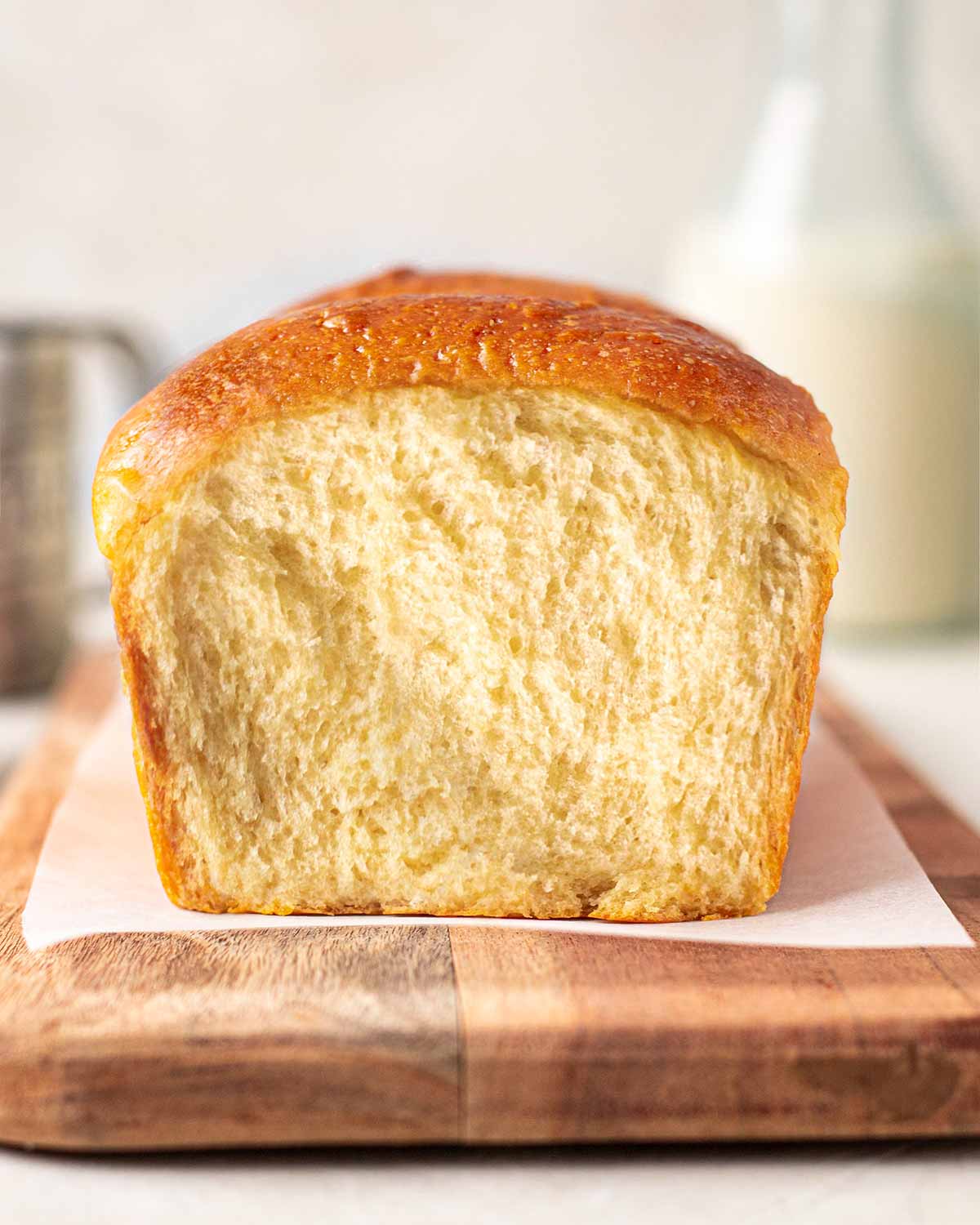
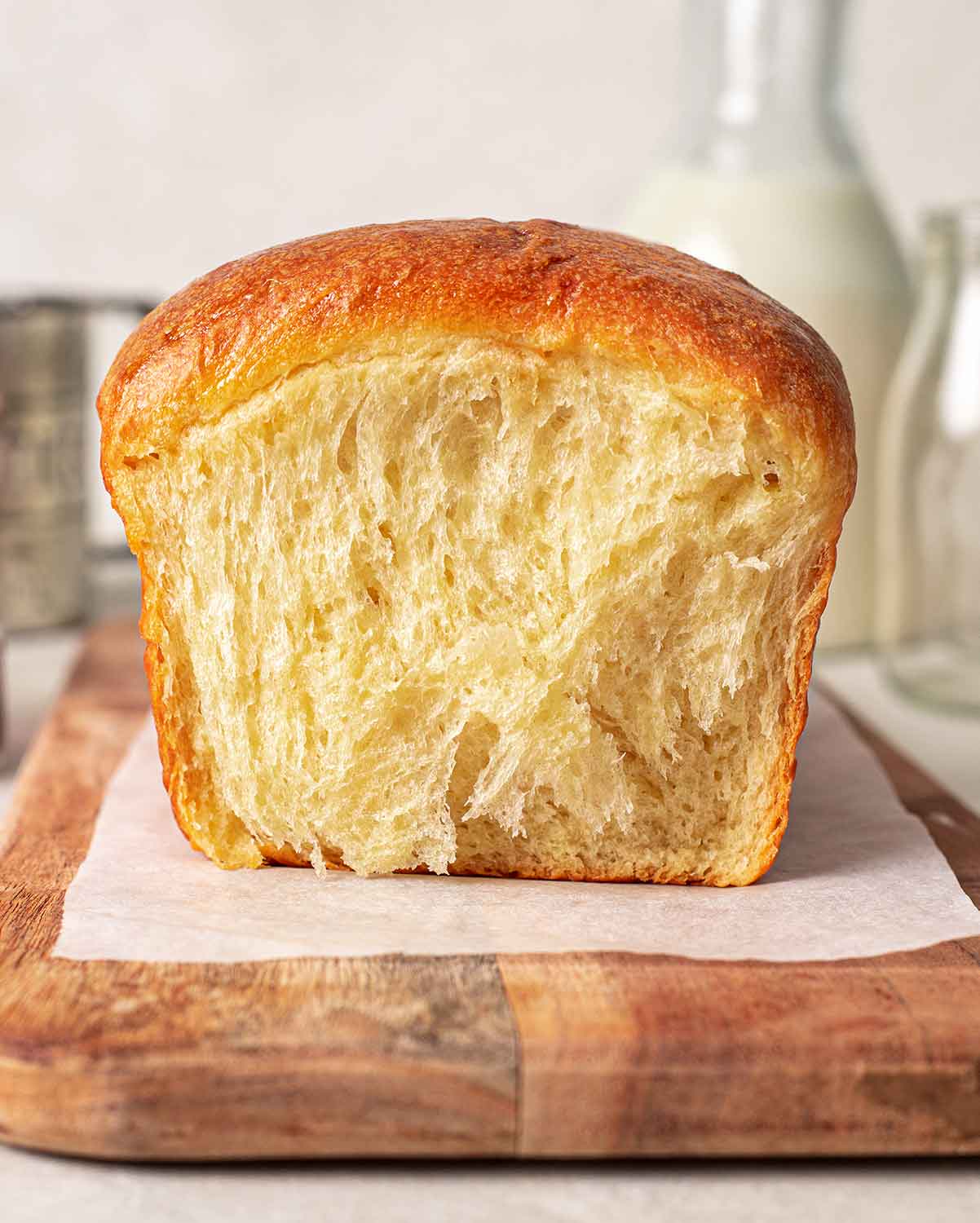
Kneading tips for the fluffiest brioche
Initially, your dough will be sticky but avoid adding more flour. Kneading the dough strengthens its gluten structure and makes it come together in a smoother ball. If your dough is still sticky after 5-10 minutes, you can add more flour.
For the 'advanced kneading method', if your dough is too dry before adding the butter, add a dash of dairy-free milk. The dough may initially resist the butter when you start adding it, but just keep kneading.
The windowpane test is the best way to tell if you've kneaded your dough enough. To do this, grab a small piece of dough and stretch it between your fingers. The dough shouldn't break and you should be able to see its 'gluten membranes'. If the dough breaks, keep kneading.
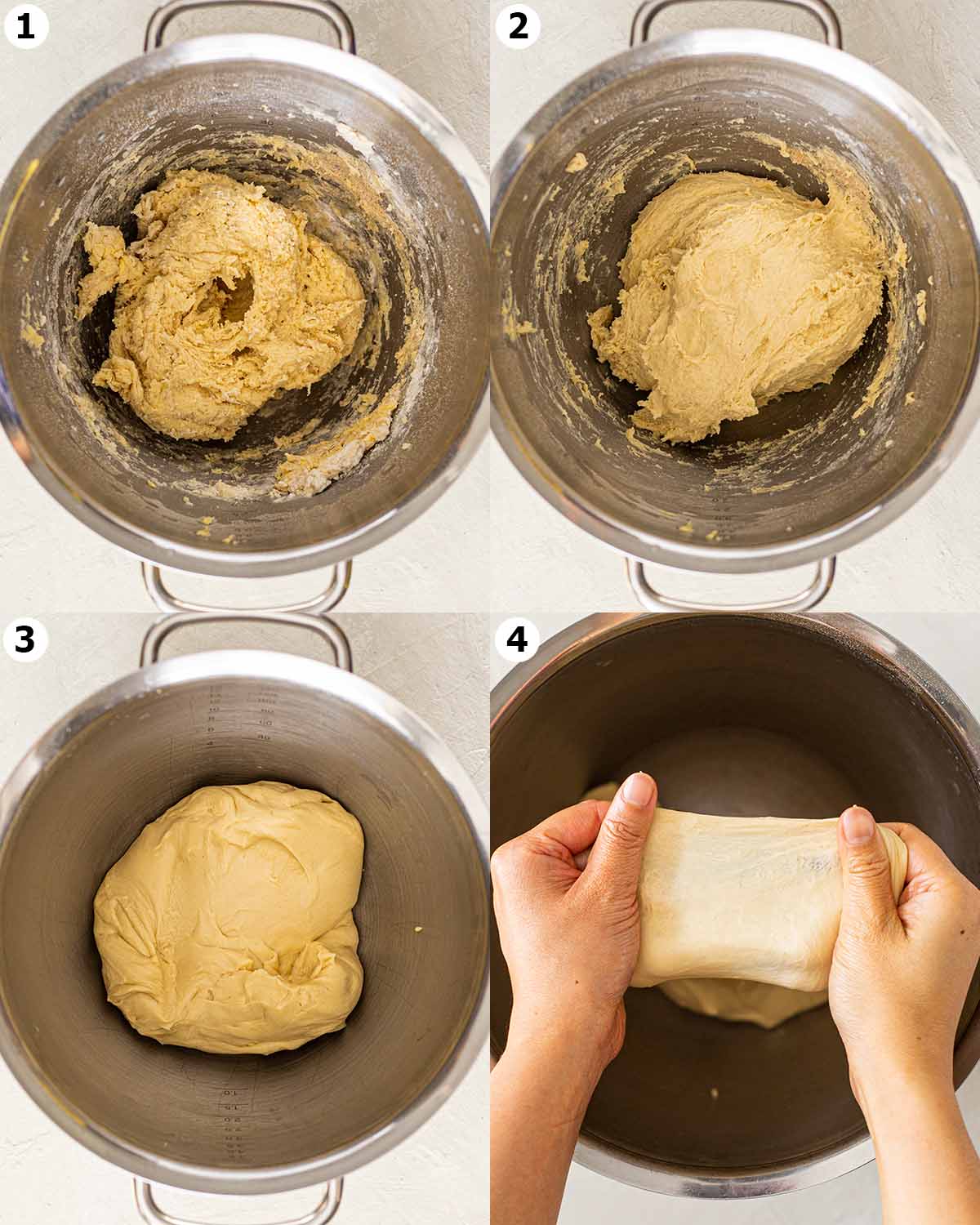
Resting the dough
After kneading the vegan brioche dough, let it rest in a WARM place for 1 hour or until it's doubled. Ideally, it should be somewhere that's around 25°C (77°F). Brioche dough has a lot of butter which can slow down its rise, but if you keep the dough in a warm place, it'll rise more efficiently.
If your dough is taking longer to rise, move it to a warmer spot in your home.
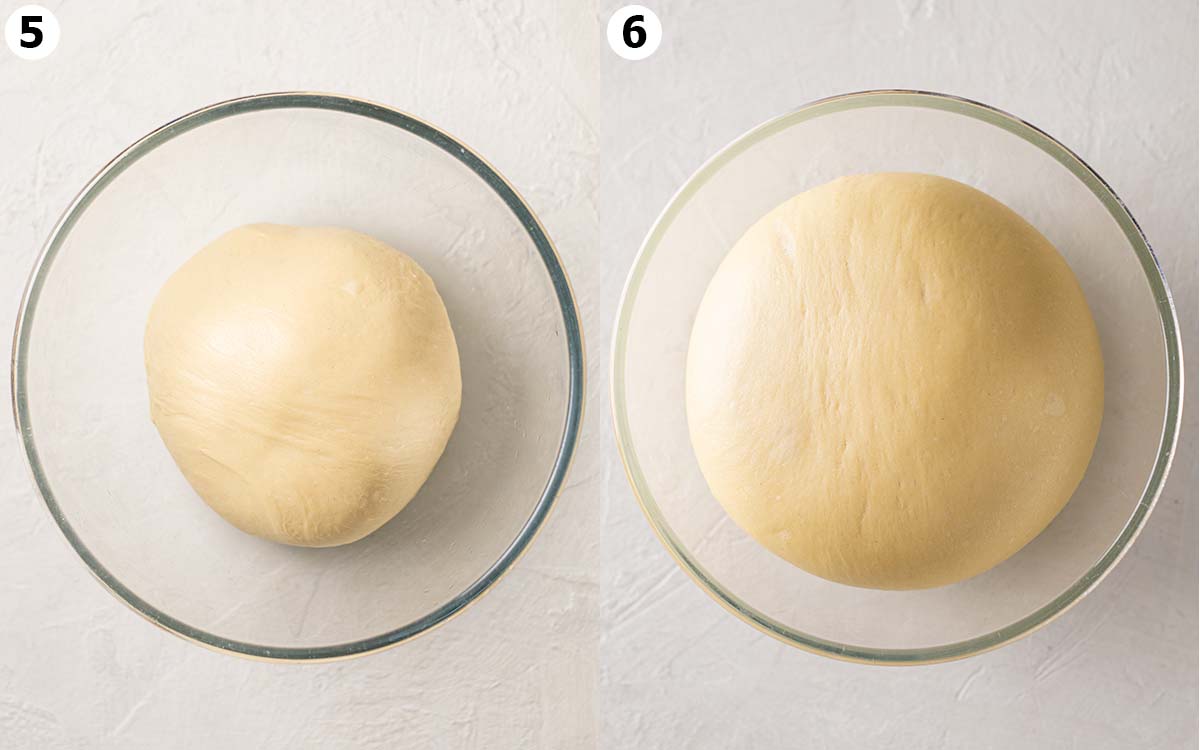
Shaping the brioche and second rise
There are a few ways you can shape vegan brioche. These are just for presentation and don't affect the texture or flavor of the bread:
- As one whole piece. Shape the dough into a large oval shape and place it your loaf pan.
- Divided into 3 to 10 equal pieces and arranged in your loaf pan.
- Braided into challah bread.
If you want to make a fancier shape, check out my cinnamon babka and raspberry jam wreath.
Finally, let your dough rest one more time. It's ready when it grows in size by about 50% and looks puffy. If you poke the surface of the loaf, it should slowly spring back (known as the poke test).
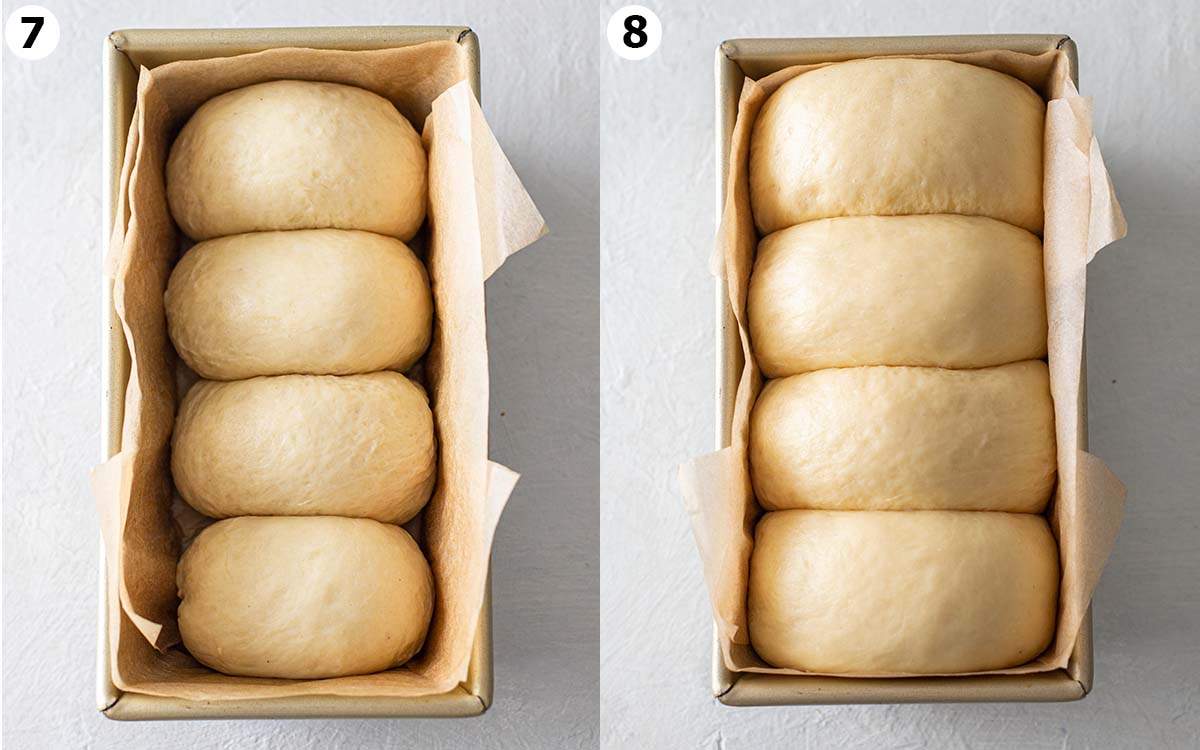
When is my brioche done baking?
Here are a few ways to tell if your vegan brioche is fully baked:
- Remove the hot brioche from the pan and tap the bottom of the loaf. Your brioche will sound hollow when it's baked through.
- Insert a toothpick into the middle, and collect some dough. If the dough is fully cooked, your brioche is ready.
- The top of the brioche should be a deep golden brown.
Instead of using egg wash, brush a little maple syrup on top of the brioche while it's warm. This will give the bread a beautiful golden shine!
See, it is 100% possible to make brioche vegan!
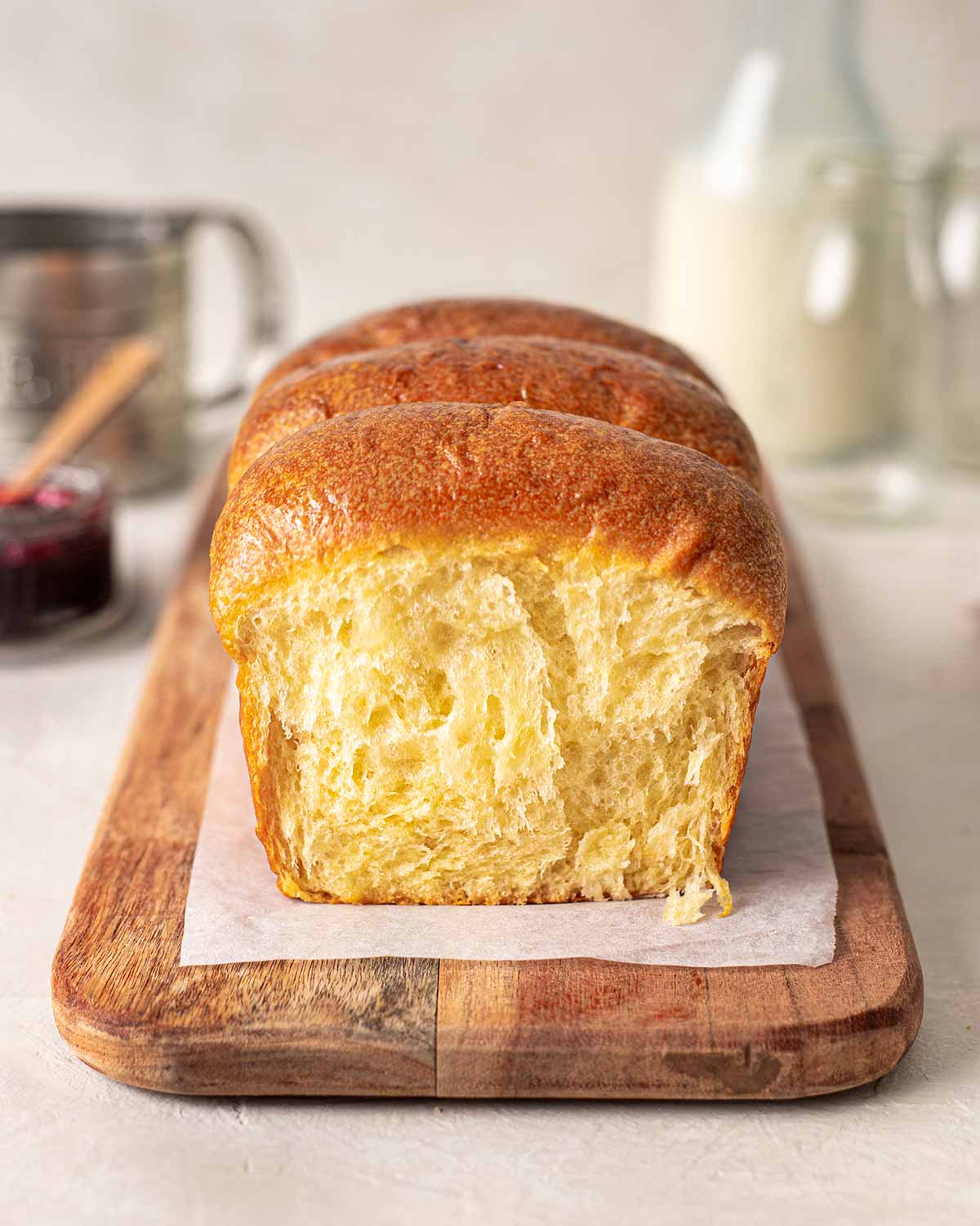
Customizing this recipe
Use whole wheat or spelt flour instead of all-purpose flour for a more wholesome and dense vegan brioche.
Replace vegan butter with extra virgin olive oil for a denser cakey bread.
Use coconut sugar or maple syrup to make this brioche refined sugar-free.
Use a sourdough starter instead of yeast. This recipe works well with 75-150g of an active sourdough starter with 100% hydration. For a stronger sourdough flavor, use more starter. Or make my sourdough cinnamon rolls!
For brioche dinner rolls and burger buns, check out my recipe for vegan brioche buns.
Unfortunately, this recipe won't work with 1:1 gluten-free flour. I am working on a gluten-free version so watch this space!
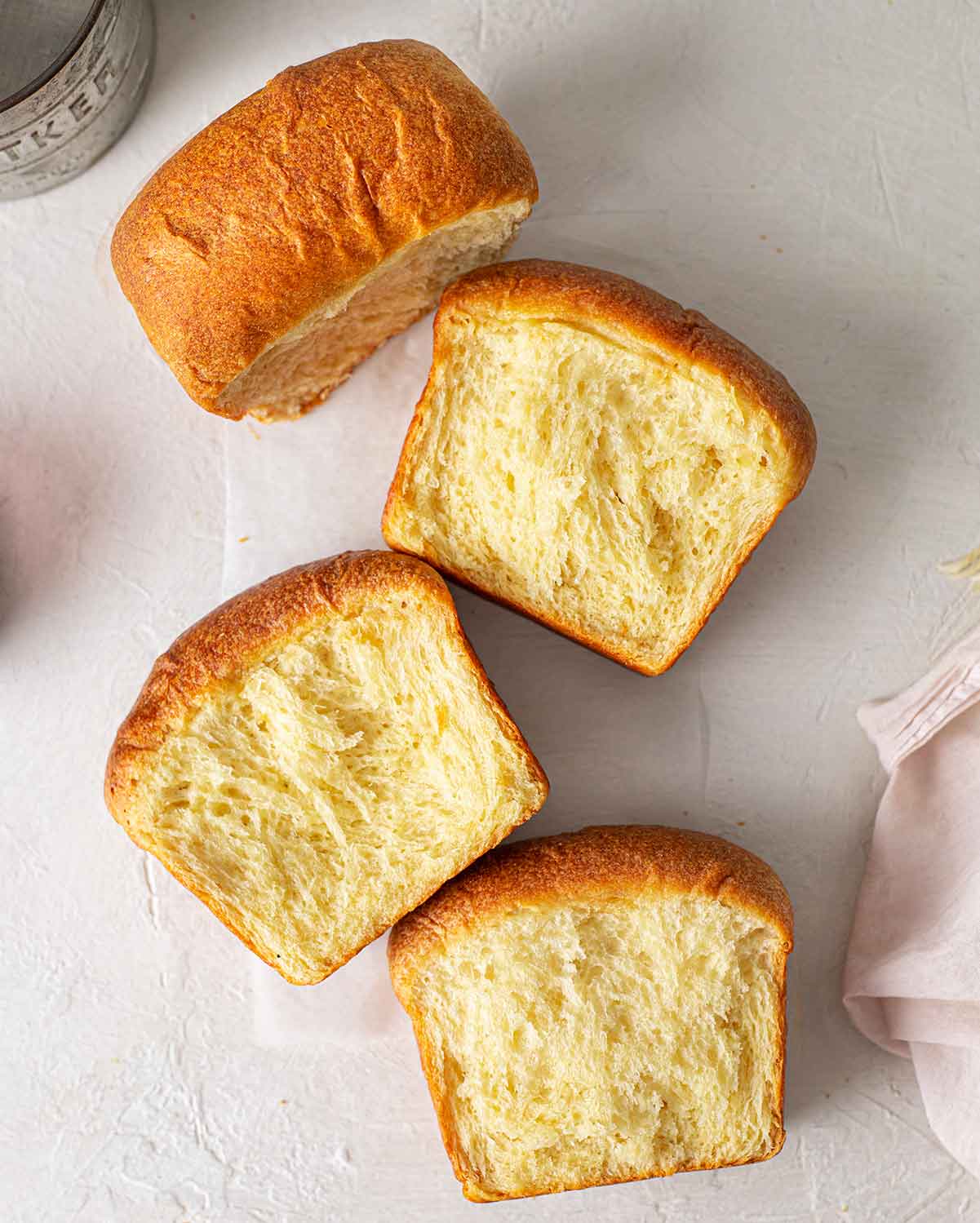
Additional Tips
Yes, prepare the dough and store it in an airtight container in the fridge overnight. The next day, when the dough is not too cold, shape it as desired then let it rest. I don't recommend shaping the brioche and storing it in the fridge because it can overproof which is more difficult to fix.
You can bake the brioche ahead of time. However, it is best enjoyed as close as possible to when it's baked. To refresh the brioche, warm it up in the oven or microwave.
Make sure your dough is resting in a warm spot. Here are some other causes and fixes:
1. Your vegan brioche dough is too dry, maybe from incorrectly measuring the flour. You can still add more dairy-free milk to your dough and knead it in. Make sure your final dough is smooth and stretchy.
2. Your yeast is old and no longer active. Don't worry, this is still fixable! Mix some active yeast with warm milk and a pinch of sugar. Wait until it bubbles then knead the mixture into the dough.
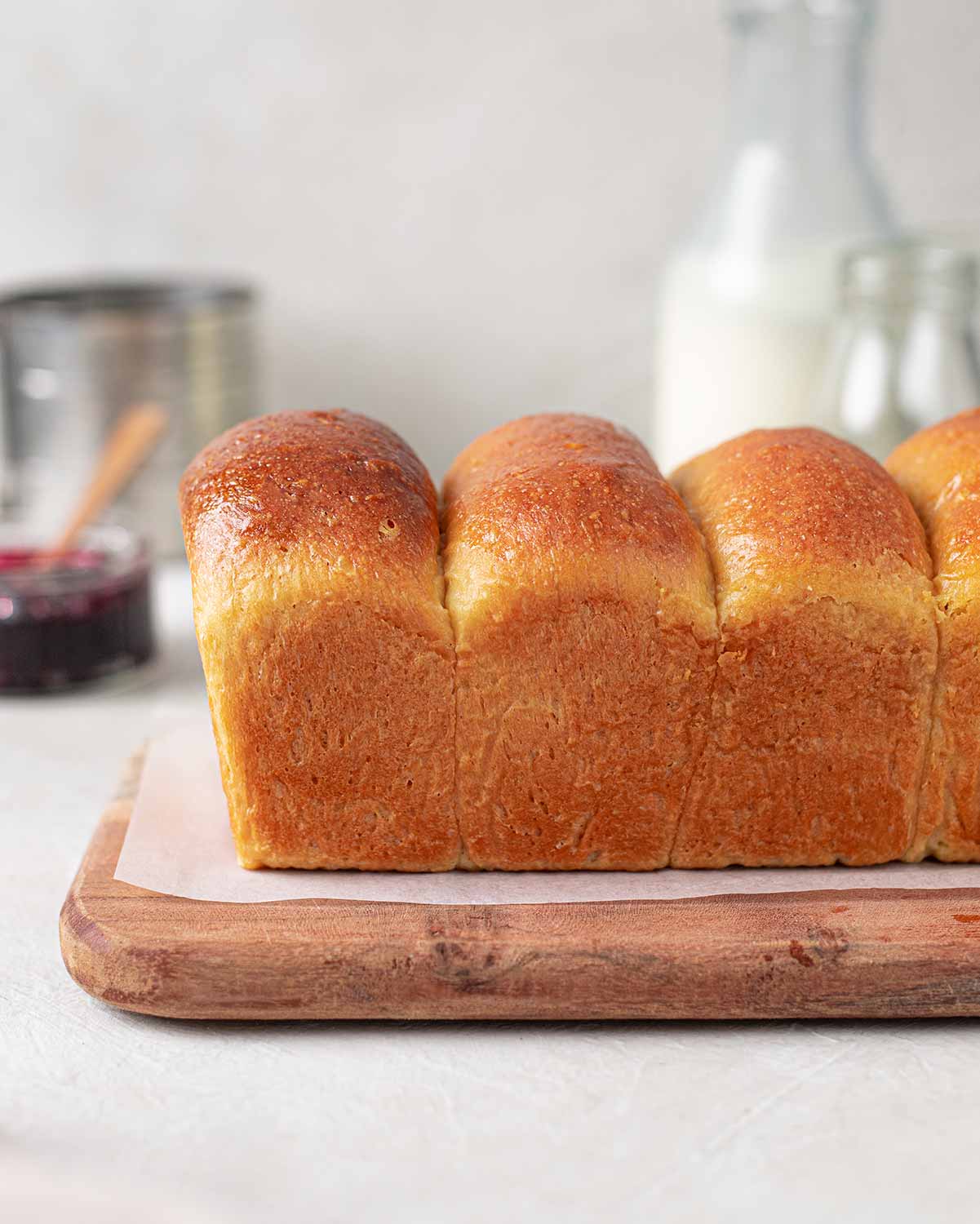
Serving suggestions
This vegan brioche is amazing when it's warm from the oven. However, here are some other ways to enjoy it:
- Toast a slice and serve it with jam, cream, or any sweet spread.
- Use stale leftovers for vegan french toast casserole. You deserve it!
- Crumble the brioche, bake it at low heat and crumble it on ice cream.
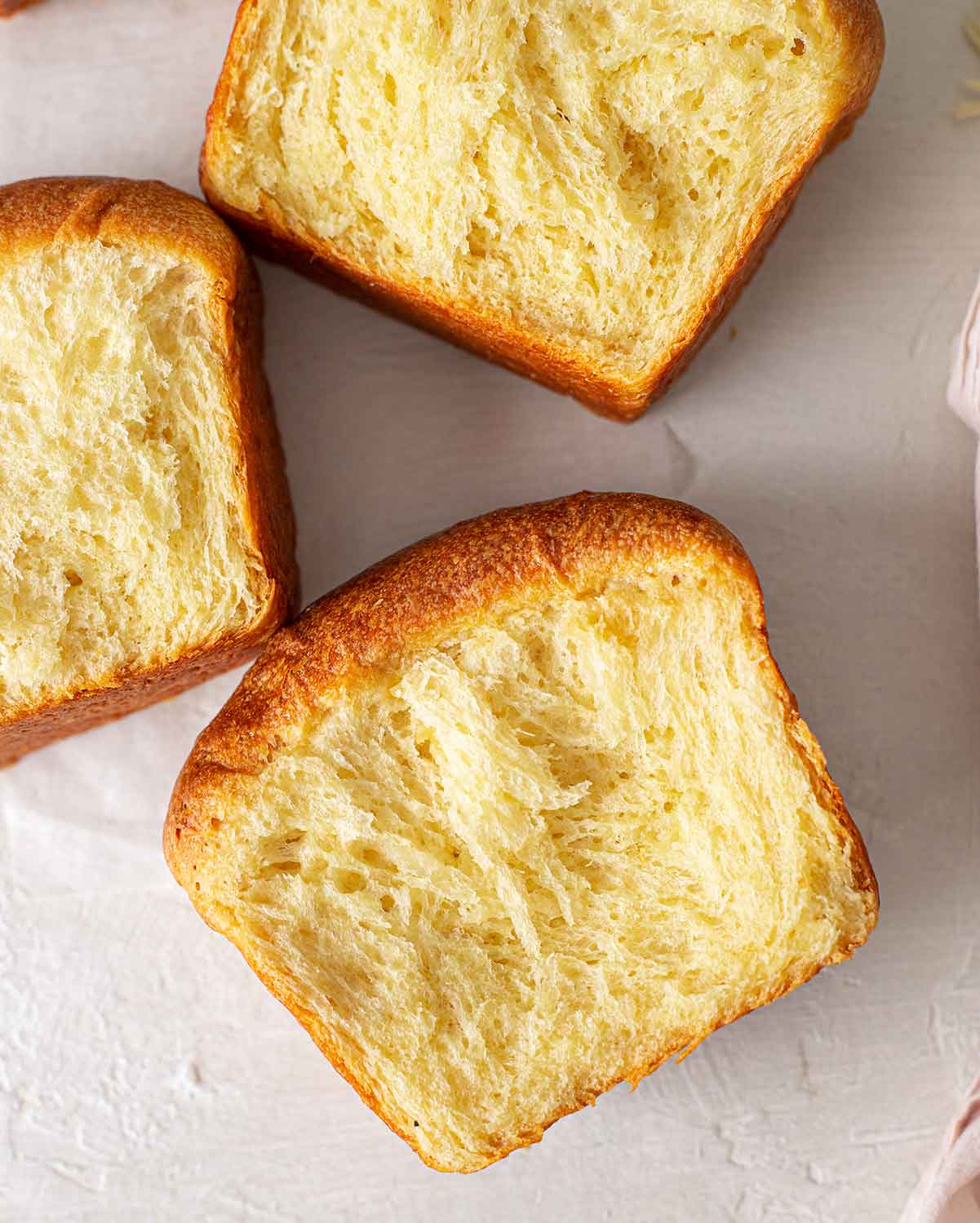
More vegan bread recipes
This brioche recipe is the base for many other bread recipes on my site! My favorites are:
Follow Rainbow Nourishments on Instagram, Facebook, TikTok and Pinterest, and subscribe via email to receive all of our latest recipes!
Buttery Vegan Brioche
Ingredients
Vegan Brioche Bread
- 3 cups (375g) bread flour, or all-purpose plain flour (note 1)
- ¾ cup (190g) dairy-free milk, warm, plus more if needed
- ⅔ cup (150g) vegan butter, room temperature (note 2 for olive oil version)
- ¼ cup (50g) granulated sugar, or coconut sugar
- 1 tablespoon instant dry yeast, (note 3 for active dry yeast)
- 1 teaspoon vanilla extract, optional
- ½ teaspoon salt, if using unsalted butter or oil
To glaze
- 3 tablespoons maple syrup, or any other light-coloured liquid sweetener
Instructions
Knead the dough:
- EASY METHOD: Add all the ingredients (except the maple syrup) to the bowl of a stand mixer with the dough hook attachment. Knead for 10 minutes or until the dough is smooth, soft and elastic. You can also mix the ingredients in a large bowl then knead the dough on a floured surface, but it will take a little longer. The dough is ready when it's smooth and tacky but comes away from the sides of the bowl. If your dough is too dry, add a little more dairy-free milk and knead well.
- ADVANCED METHOD: Add all the ingredients except the butter and maple syrup to a stand mixer with the dough hook. Knead until the mixture is well combined (at least 5 minutes). If your dough isn't coming together, add a little dairy-free milk. While the dough is kneading, gradually add the butter, around 3 tablespoons (40g) at a time. Knead until the dough is very smooth and comes away from the sides of the bowl (at least 15 minutes).
- Place the dough in a clean bowl and cover with a tea towel. Let the dough rest in a WARM spot for at least 1 hour or until it doubles in size (note 4).
Shape the vegan brioche:
- Line an 8-inch (20cm) loaf pan with parchment paper or dust with flour.
- Divide the dough into 4 equal portions, shape each into a ball and arrange them in your loaf pan. Cover the loaf pan with a tea towel and leave it in a warm spot to rest for at least 1 hour. The dough should grow by 50% - 100% and become puffy again.
Bake the vegan brioche:
- When you're ready to bake, preheat the oven to 180°C (350°F).
- Bake the brioche for 30-40 minutes or until the top is deep golden brown. The loaf is fully cooked when you can tap the bottom of the loaf and it sounds hollow. If you poke a skewer in the middle, it shouldn't collect any raw dough. If your brioche is browning too quickly but is not baked through, reduce your oven to 160°C (320°F) and tent the brioche with aluminum foil.
- While the brioche is still hot from the oven, brush the top with maple syrup. Rest the bread in the pan for 15 minutes then transfer it to a wire rack to cool.
- Serve the brioche warm. Store leftovers in an airtight container at room temperature for up to 3 days, in the fridge for 5 days or in the freezer for up to 1 month. Leftover brioche is best enjoyed warmed or toasted.
Notes
- Bread flour gives you a chewier brioche whereas all-purpose flour results in a cake-like brioche. You can use whole wheat flour or white spelt flour, but I suggest adding an extra dash of plant milk.
- Instead of vegan butter, you can use ½ cup (125g) of olive oil. This makes a softer dough and you may need to add a little extra flour. And, don't skip the salt as it mimics a 'buttery' taste.
- Instant yeast doesn't need to be 'proofed' beforehand. If you use active dry yeast, mix it with the warm milk from the recipe and a pinch of sugar in a small bowl beforehand. Wait until it bubbles then use it in the recipe.
- The dough can take anywhere from 1-4 hours to rise, depending on the temperature of your home and your dough. If your dough doesn't grow, place it in a warmer spot in your house. Read my post above for some tips.
Nutrition
This post was originally published in August 2019 and has been updated a few times with an improved recipe that is more similar to traditional French brioche.
This post may contain affiliate links. As an Amazon Associate, I may earn a small commission from qualifying purchases at no additional cost to you.
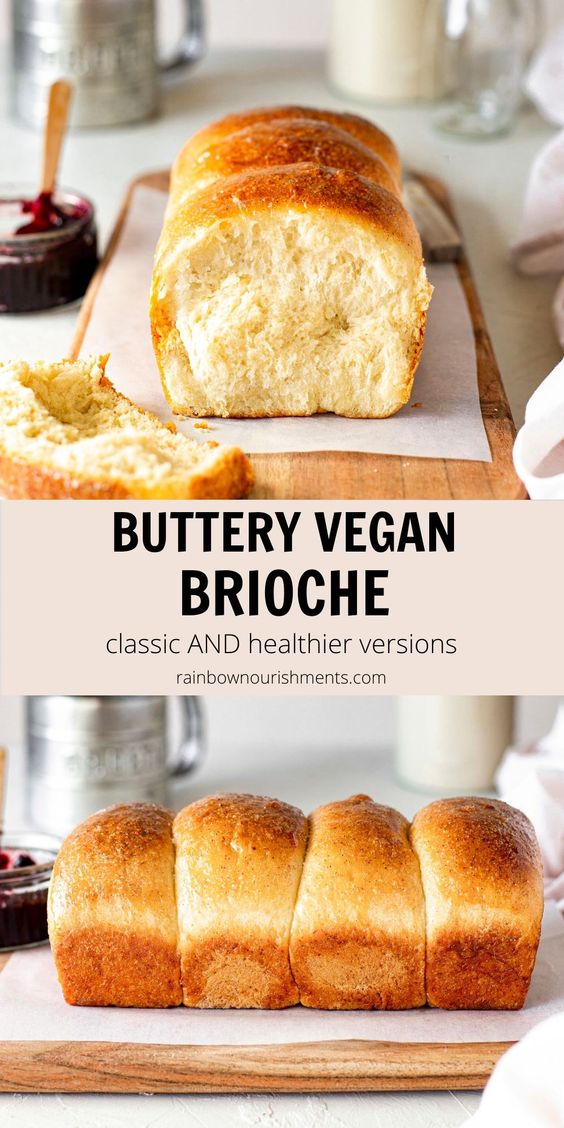


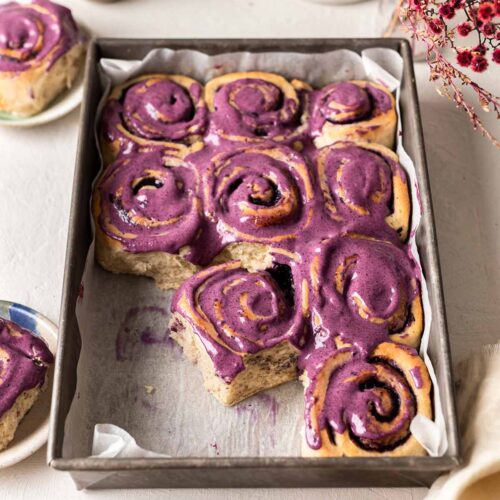
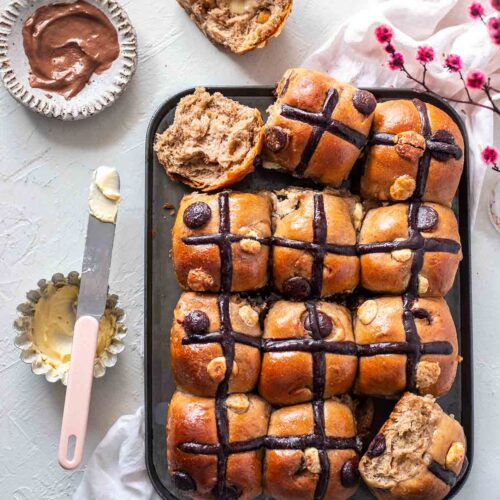
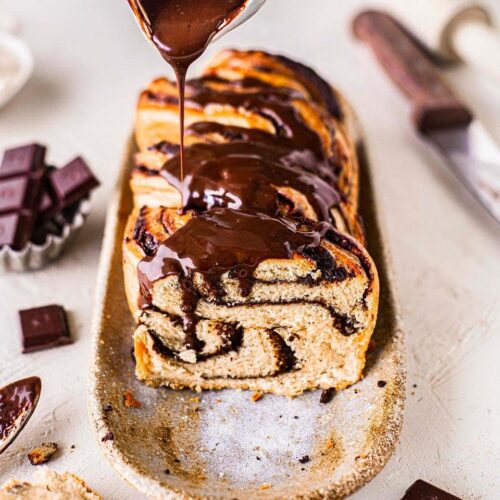
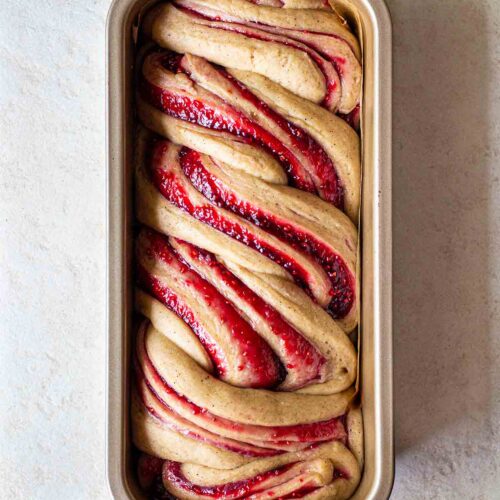
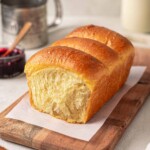
Hi! I want to make a gluten free version but I am afraid of the texture not turning out well. Do you have any suggestions of what flours I can use?
Thank you!
Hi Maria, I've tried this recipe with a few gluten-free all-purpose flours and individual flours but the results weren't great. When testing the individual flours, each time, I combined 2-3 of the following flours: rice, sorghum, almond, buckwheat, tapioca and potato. However, I still haven't been able to perfect it! Let me know if you do any experimentation with this recipe!
I baked it this afternoon and it turned out amazing. Thank you for sharing this delicious recipe!!
I'm so stoked to hear that Carla! Thanks for your feedback 🙂
I just finished making the bread and it’s absolutely perfect. It’s always a miss when I bake bread (I don’t why) but this one came out the way I wanted it. Thank you Anthea for the wonderful recipe.
That's amazing Rhulia! Yes, bread can be a hit and miss due to sooo many factors but I'm so happy this was perfect for you :). Thank you!
I also have problems with other bread recipes. I have started weighing in grams and it has helped.
OMG! I found your recipe the other day and honestly didn’t think it would work. Not only did it taste amazing, the crumb was just like regular brioche BUT I made it in my bread maker. I used exactly your recipe (easy method) but put it into my bread maker in the order they like and switched it onto the brioche setting. 3 1/2 hours later out came perfect brioche. Well if the truth were known the crust was possibly a little dark so next time (and there will absolutely be a next time) I will take it out maybe 10 minutes earlier. Thank you, thank you, thank you for this recipe and if anyone else wants to experiment in their breadmaker I would say to give it a go. My breadmaker is a Panasonic BTW.
Aw, I'm so glad this brioche exceeded your expectations and you really loved the texture! And it's amazing that it worked in your breadmaker too! I hear you about the crust - sometimes that happens to me when I bake it for too long or the heat is a little high :). Thank you so much for your feedback - I appreciate it a lot!
Very good recipe! Easy and adaptable as I added cinnamon, dried fruit etc. I will keep this in my permanent bookmark.
Thanks Anthea!
So glad you enjoyed this and were able to customise it too! Thanks for your comment! xx
Loved the recipe, but I thought this was sugar free. Is there a way to replace sugar with maple or agave nectar?
This recipe isn't meant to be sugar-free but I included a refined sugar-free option above! You can replace the sugar with coconut sugar, maple syrup or agave. You can use anywhere between 1 tablespoon to 1/4 cup of those sweeteners.
Just made this brioche and it turned out PERFECT! I used the easy method to combine the dough, and I think it still came out pretty feathery! Thanks for the amazing recipe, Anthea!
I absolutely LOVED the look of your brioche on your Instagram! I'm so happy that yours came out extremely feathery even with using the easy method :). Thanks so so much for your feedback x
Howdy do,
So I believe that learning should be done HARD, which is why I went all-in on a double recipe of this brioche using olive oil (no emulsifiers to ease combination with the dough) and no stand mixer. On the plus side, working with all that olive oil for so long left my butcher block gloriously oiled and my hands looking like those of an Italian supermodel. On the minus side, it did take me a full hour of kneading to get a luscious, smooth, supple brioche dough. The dough rose beautifully, my buns came out deeply browned and shining thanks to the maple glaze, and the final product was so worth the labor.
Additions - 1 tsp orange flower water in the dough + 1/2 tsp orange flower water in the glaze. It goes marvelously with the olive oil.
I absolutely loved reading your comment and laughed out loud when you said 'hands of an Italian supermodel' hahahaha. I'm glad your dough finally got there and it sounds like you got an excellent arm workout and a renewed butchers block :). Glad you enjoyed the brioche with olive oil and absolutely love the sound of orange flower water - I can only imagine how fragrant it'd make the brioche! Thanks so so much for your lovely comment and for making my day! 🙂
I previously made your brioche buns and they were really nice and soft and worked out really well. I thought I’d give this brioche loaf recipe a try and it is just a great recipe. My dough was perfect and I got a good first rise. I actually made the dough the night before, left it in the fridge overnight then took it out the next morning to warm up before doing the second rise.
The loaf is soft and delicious. Definitely will be my go to recipe.
Thanks Anthea for sharing a great, easy to follow recipe.
That's amazing Margaret! Glad you liked both recipes and the overnight rise worked well for you :). Thanks so much for taking the time to leave a review! Enjoy the rest of your bread, if there's any left x
Great recipe! I love it when its hot and I add jam to it. Kind of like a thick croissant. <3
So stoked that you love this brioche! I agree, it's best when it's served warm/hot 🙂
I'll preface this review by saying that I understand brioche is pretty darn hard to replicate when so many of the main ingredients are not vegan. My experience with this recipe is that it produces a bland though still somewhat tasty and solid bread. But it has none of the delicately flakey, buttery, slightly sweet richness of brioche and I wouldn't call it such.
I'd recommend it as an easy, slightly more indulgent loaf recipe, especially if made slightly sweeter, but not as a brioche replacement. Looking forward to trying other vegan brioche recipes that make use of longer/cold ferments and aquafaba as the photos from those seem to show that characteristic flakiness of this iconic bread.
Thank you to the author for creating and sharing this recipe! 🙏
Hi Aly, thanks for your feedback and I'm sorry you didn't like the recipe. It's the first time a reader has said that the recipe was bland yet tasty and solid. Thank you for your feedback.
Hello! And first of all, thank you for the recipe, I know how hard it can be sometimes to veganise a recipe, with all the trials and errors.
I have a question as this is probably the 4th recipe I've been trying and still the same result: as mixing and kneading, I still end up with what I could call a 'shaggy mess'... No way I can shape any form from the dough. So, after a time of reflexion and deep thoughts, I was wondering: what is the fat content of your vegan butter? Mine is 54%, which is far away from butter (around 80%). That means that I have a lot more liquid (water or whatever this can be) and I end up with a very very soft dough. Depending on the fat content of your vegan butter, I can maybe make some calculations to decrease the amount of milk to add to the mixture... Just a though but I will definitely give a try and keep you posted. Thanks again for the recipe, that would be brilliant to have some vegan brioche for breakfast, once I've sorted out my fatty problem 🙂
Hi Nicolas, it's my pleasure!
The brioche dough starts off as a 'shaggy mess' but kneading the dough strengthens its gluten and reduces its stickiness so it becomes a smooth ball. It can take my stand mixer over 10 minutes for the dough to come together, so it'll take longer if you're kneading by hand! I've tested this recipe with both a vegan butter spread (around 50% fat) and a vegan block butter (around 80% fat) and they both work well. The butter spread will create a stickier dough so you'll need add a little more flour or decrease the milk, as you mentioned. I hope that helps, and let me know if you have any other questions!
Thank you Anthea, those were my thoughts, i.e. that the fat content may impact the consistency of the dough... I've tried to make some calculations and roughly, I think I end up with your recommendations when using a 50% fat content vegan butter: less milk and a bit more flour.
Anyway, I will try with a higher fat content vegan butter (around 78%) and will tell you how it turns out!
Thanks again for your time and let's keep in touch. Happy baking!
Can this be made with Oat milk?
Yes!
I just tried making this yesterday and it turned out so well! The texture of the loaf is super soft and fluffy - honestly it doesn’t seem any different from a regular brioche.
I used my sourdough starter instead of instant yeast and left it overnight to proof in the fridge, so the loaf had a delightfully tangy taste. I also used almond milk, which left a slight taste so will try and make this the next time with soy milk instead.
Thank you Anthea for this recipe! I’ve been meaning to try a vegan brioche for a while now so I’m really glad I found yours 🙂
That's amazing you found it as delicious as a regular brioche and I'm so glad it worked with a sourdough starter too!! Soo interesting about the milk but good idea to use soy milk next time (it's my fav). Thanks so much for taking the time to leave your feedback xo
Hey from Latvia! We absolutely loved this recipe and ate it all in minutes! Thanks!
Aw I'm so happy to hear that! Thanks for your feedback x
Hey you say that if the brioche isn't cooked in the middle to cover it up but isn't it then too late to cover it up ?
No it isn't too late - covering the brioche in the later part of baking traps in the heat so there isn't as much heat hitting the surface of the loaf. It's just like baking a cake, like what Nigella says here.
Is there anyway to skip the sugar altogether, please?
Sugar is needed in all breads (except sourdough) as it activates the yeast. However, you can possibly reduce the sugar to 1 tbsp or replace it with maple syrup (though your bread may be a little more dense). Stevia and monk fruit sweetener will not work.
This brioche was amazing!!!!